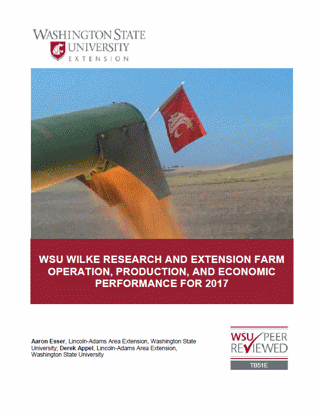You have no items in your shopping cart.
Agriculture Business
Agriculture Business
Wheat and Canola Rotations in Eastern Washington Intermediate Rainfall Regions 12" to 16" (Oilseed Series)
This publication explains how to use a custom Excel spreadsheet to estimate the costs and returns for an enterprise involving wheat and canola grown in rotation in parts of eastern Washington.
$0.00
Wheat and Canola Rotations in Eastern Washington Low Rainfall Regions (<12") --(Oilseed Series)
These budgets were constructed for the Washington Oilseed Cropping Systems (WOCS) project, part of the Washington state biofuels initiative.
$0.00
Wheat Farmers Adopt the Undercutter Fallow Method to Reduce Wind Erosion and Sustain Profits
Excessive tillage—especially in the low-precipitation wheat production region of the Inland Pacific Northwest—causes blowing dust, which results in soil loss as well as air quality degradation. Yet mo ...
$0.00
Wilke Research and Extension Farm Operation, Production, and Economic Performance for 2017
WSU Wilke Research and Extension Farm Operation, Production, and Economic Performance for 2017 ...
$0.00
Winter Canola Feasibility in Rotation with Winter Wheat
This fact sheet is designed to help farmers determine if it is economically feasible to produce winter canola in rotation as an alternative to winter wheat. Rotating to canola has risks associated wit ...
$0.00
WSU Carcass Calculator App: A Quick and Easy Way to Calculate Carcass Merit
Looking for a way to calculate dressing percentage, estimated yield grade, actual yield grade, and cutability for beef, lambs, and pigs? Find out more here. ...
$0.00
WSU Drought Advisory: Alfalfa Irrigation with Reduced Water Supplies
Alfalfa grown for forage in the arid Northwest requires 1.8-acre feet to 3.2-acre feet of water per year, depending on length of the growing season. This drought advisory recommends steps to take in l ...
$0.00
WSU Drought Advisory: Asparagus Irrigation in a Water-Short Year
The primary water absorption root zone for asparagus is down three to four feet in irrigated fields. Fill root zone early when water is short. Weed control becomes especially important in a drought ye ...
$0.00
WSU Drought Advisory: Hop Management in Water-Short Periods
Hop plants are fairly drought resistant. Author offers measures to ensure greater success under dry conditions. Discusses factors influencing some cultivars and water and fertilization patterns for di ...
$0.00









